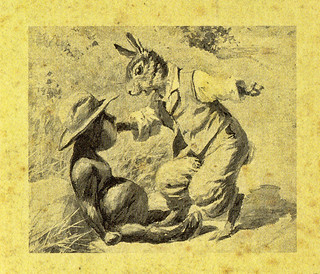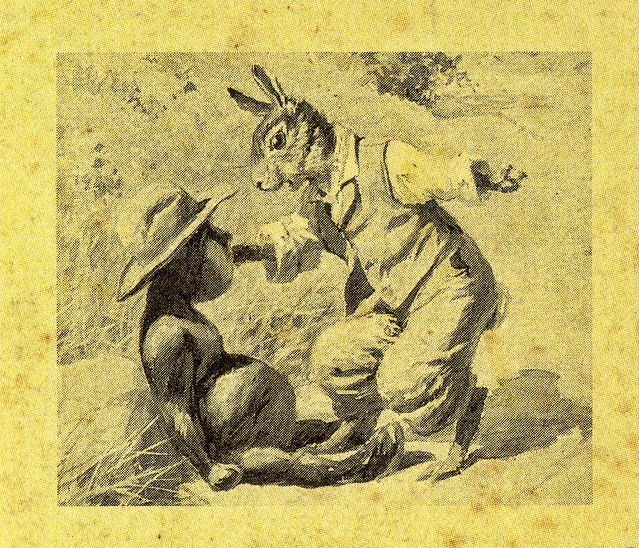
The African Origins of The Br''er Rabbit Tales
The Br'er Rabbit stories can be traced back to trickster figures in Africa, particularly the hare that figures prominently in the storytelling traditions in Western Africa, Central Africa, and Southern Africa. These tales continue to be part of the traditional folklore of numerous peoples throughout those regions. In the Akan traditions of West Africa, the trickster is usually the spider though the plots of tales of the spider are often identical with those of stories of Br'er Rabbit..
Some scholars have suggested that in the American incarnation, Br'er Rabbit represented the enslaved Africans who used their wits to overcome adversity and to exact revenge on their adversaries, the White slave-owners. Though not always successful, the efforts of Br'er Rabbit made him a folk hero. However, the trickster is a multidimensional character. While he can be a hero, his amoral nature and his lack of any positive restraint can make him into a villain as well.
Brer Rabbit, trickster figure originating in African folklore and transmitted by African slaves to the New World, where it acquired attributes of similar native American tricksters Brer, or Brother, Rabbit was popularized in the United States in the stories of Joel Chandler Harris (1848–1908). Brer Rabbit's adventures embody an idea considered to be a universal creation among oppressed peoples—that a small, weak, but ingenious force can overcome a larger, stronger, but dull-witted power. Brer Rabbit continually outsmarts his bigger animal associates, Brer Fox, Brer Wolf, and Brer Bear.
African origins
The Br'er Rabbit stories can be traced back to trickster figures in Africa, particularly the hare that figures prominently in the storytelling traditions in Western Africa, Central Africa, and Southern Africa. These tales continue to be part of the traditional folklore of numerous peoples throughout those regions. In the Akan traditions of West Africa, the trickster is usually the spider though the plots of tales of the spider are often identical with those of stories of Br'er Rabbit..
Some scholars have suggested that in the American incarnation, Br'er Rabbit represented the enslaved Africans who used their wits to overcome adversity and to exact revenge on their adversaries, the White slave-owners. Though not always successful, the efforts of Br'er Rabbit made him a folk hero. However, the trickster is a multidimensional character. While he can be a hero, his amoral nature and his lack of any positive restraint can make him into a villain as well.
The American versions of the stories are said to have originated among enslaved Africans. The stories of Br'er Rabbit were written down by Robert Roosevelt, an uncle of President Theodore Roosevelt. Theodore Roosevelt wrote in his autobiography about his aunt from the State of Georgia, that "She knew all the 'Br'er Rabbit' stories, and I was brought up on them. One of my uncles, Robert Roosevelt, was much struck with them, and took them down from her dictation, publishing them in Harper's, where they fell flat. This was a good many years before a genius arose who, in 'Uncle Remus', made the stories immortal."
These stories were popularized for the mainstream audience in the late 19th century by Joel Chandler Harris (1845–1908), who wrote down and published many of the stories that had been passed down by oral tradition. Harris also attributed the birth name, Riley, to Br'er Rabbit. Harris heard these tales in Georgia. Very similar versions of the same stories were recorded independently at the same time by the folklorist Alcée Fortier in southern Louisiana, where the Rabbit character was known as Compair Lapin in Creole French. Enid Blyton, the English writer of children's fiction, retold the stories for children.
Brer Rabbit, trickster figure originating in African folklore and transmitted by African slaves to the New World, where it acquired attributes of similar native American tricksters Brer, or Brother, Rabbit was popularized in the United States in the stories of Joel Chandler Harris (1848–1908). Brer Rabbit's adventures embody an idea considered to be a universal creation among oppressed peoples—that a small, weak, but ingenious force can overcome a larger, stronger, but dull-witted power. Brer Rabbit continually outsmarts his bigger animal associates, Brer Fox, Brer Wolf, and Brer Bear.
African origins
The Br'er Rabbit stories can be traced back to trickster figures in Africa, particularly the hare that figures prominently in the storytelling traditions in Western Africa, Central Africa, and Southern Africa. These tales continue to be part of the traditional folklore of numerous peoples throughout those regions. In the Akan traditions of West Africa, the trickster is usually the spider though the plots of tales of the spider are often identical with those of stories of Br'er Rabbit..
Some scholars have suggested that in the American incarnation, Br'er Rabbit represented the enslaved Africans who used their wits to overcome adversity and to exact revenge on their adversaries, the White slave-owners. Though not always successful, the efforts of Br'er Rabbit made him a folk hero. However, the trickster is a multidimensional character. While he can be a hero, his amoral nature and his lack of any positive restraint can make him into a villain as well.
The American versions of the stories are said to have originated among enslaved Africans. The stories of Br'er Rabbit were written down by Robert Roosevelt, an uncle of President Theodore Roosevelt. Theodore Roosevelt wrote in his autobiography about his aunt from the State of Georgia, that "She knew all the 'Br'er Rabbit' stories, and I was brought up on them. One of my uncles, Robert Roosevelt, was much struck with them, and took them down from her dictation, publishing them in Harper's, where they fell flat. This was a good many years before a genius arose who, in 'Uncle Remus', made the stories immortal."
These stories were popularized for the mainstream audience in the late 19th century by Joel Chandler Harris (1845–1908), who wrote down and published many of the stories that had been passed down by oral tradition. Harris also attributed the birth name, Riley, to Br'er Rabbit. Harris heard these tales in Georgia. Very similar versions of the same stories were recorded independently at the same time by the folklorist Alcée Fortier in southern Louisiana, where the Rabbit character was known as Compair Lapin in Creole French. Enid Blyton, the English writer of children's fiction, retold the stories for children.
Brer Rabbit, trickster figure originating in African folklore and transmitted by African slaves to the New World, where it acquired attributes of similar native American tricksters Brer, or Brother, Rabbit was popularized in the United States in the stories of Joel Chandler Harris (1848–1908). Brer Rabbit's adventures embody an idea considered to be a universal creation among oppressed peoples—that a small, weak, but ingenious force can overcome a larger, stronger, but dull-witted power. Brer Rabbit continually outsmarts his bigger animal associates, Brer Fox, Brer Wolf, and Brer Bear.
African origins
The Br'er Rabbit stories can be traced back to trickster figures in Africa, particularly the hare that figures prominently in the storytelling traditions in Western Africa, Central Africa, and Southern Africa. These tales continue to be part of the traditional folklore of numerous peoples throughout those regions. In the Akan traditions of West Africa, the trickster is usually the spider though the plots of tales of the spider are often identical with those of stories of Br'er Rabbit.
Some scholars have suggested that in the American incarnation, Br'er Rabbit represented the enslaved Africans who used their wits to overcome adversity and to exact revenge on their adversaries, the White slave-owners. Though not always successful, the efforts of Br'er Rabbit made him a folk hero. However, the trickster is a multidimensional character. While he can be a hero, his amoral nature and his lack of any positive restraint can make him into a villain as well.
The American versions of the stories are said to have originated among enslaved Africans. The stories of Br'er Rabbit were written down by Robert Roosevelt, an uncle of President Theodore Roosevelt. Theodore Roosevelt wrote in his autobiography about his aunt from the State of Georgia, that "She knew all the 'Br'er Rabbit' stories, and I was brought up on them. One of my uncles, Robert Roosevelt, was much struck with them, and took them down from her dictation, publishing them in Harper's, where they fell flat. This was a good many years before a genius arose who, in 'Uncle Remus', made the stories immortal."
These stories were popularized for the mainstream audience in the late 19th century by Joel Chandler Harris (1845–1908), who wrote down and published many of the stories that had been passed down by oral tradition. Harris also attributed the birth name, Riley, to Br'er Rabbit. Harris heard these tales in Georgia. Very similar versions of the same stories were recorded independently at the same time by the folklorist Alcée Fortier in southern Louisiana, where the Rabbit character was known as Compair Lapin in Creole French. Enid Blyton, the English writer of children's fiction, retold the stories for children.























